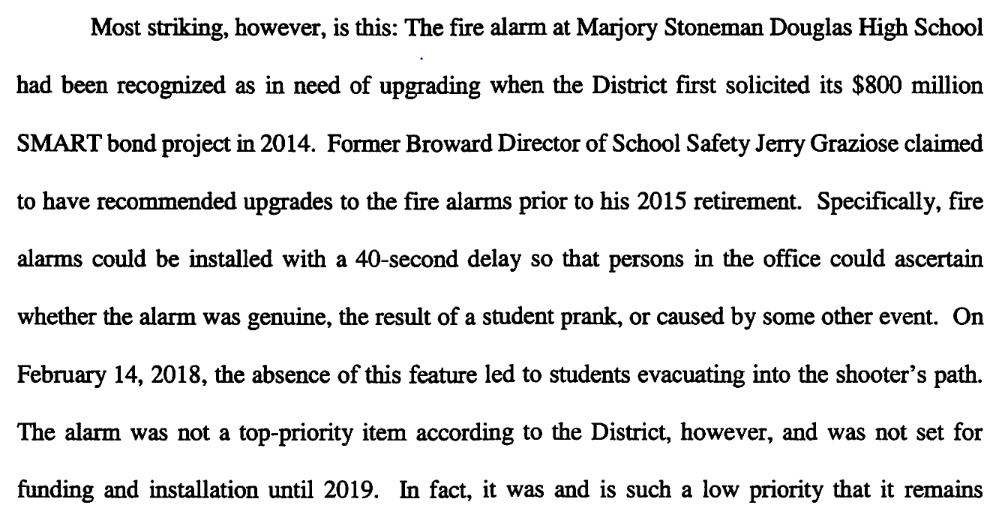FORT LAUDERDALE, Fla. – More than half of a recent report by the state grand jury that the Florida Supreme Court empaneled as a response to the 2018 Valentine’s Day massacre at Marjory Stoneman Douglas High School in Parkland focused on a program funded by Broward County taxpayers.
The grand jury warned Broward County Public Schools is running out of money to support The SMART bond project and had to empty capital reserves by issuing a series of mortgages on its own real estate properties, which must be paid back with interest over the next 14 years.
The school board was on notice that costs were on their way up, and the scope of work promised at $937 million was now likely going to cost at least $1.171 billion — before the actual projected cost increased to $1.462 billion, according to the grand jury.
“The Board cannot continue to give the District a blank check to incompetently manage these The SMART bond projects. It has to end,” the grand jury wrote.
The grand jury recommended that Gov. Ron DeSantis remove four sitting Broward County Public Schools board members and reported there is a need for “housecleaning” of the school district’s administration.
The value increased by more than 50% from what was originally told to voters in 2014. And while Broward County taxpayers have paid the cost, students continue to be educated in decrepit, moldy, and unsafe buildings, according to the grand jury report.
The grand jury report cites several examples including a critical priority project at Pasadena Lakes Elementary School, at 8801 Pasadena Blvd., in Pembroke Pines. It started in 2015 and was over budget by $2 million, according to the report.
“Should Pasadena Lakes remain on its current schedule, it will have taken over nine years to complete. Simply put, on this trajectory, a third grader ... at the time this project was funded will be in college by the time it is completed.”
There is urgency. The list of schools with mold and mildew problems while waiting for new roofs through the SMART program includes Quiet Waters, Sheridan Park, Palmview, North Fork, Royal Palm, and Stephen Foster elementary schools, according to the grand jury.
Lori Alhadeff, a school board member and the mother of one of the 17 victims, released a statement saying the grand jury’s findings were distressing. The grand jury was aware that Alhadeff brought a motion to terminate former Broward Schools Superintendent Robert Runcie for cause on March 5, 2019, alleging he had failed to properly manage the program.
The grand jury accused Runcie, four sitting school board members — Ann Murray, Donna Korn, Laurie Rich Levinson, and Patricia Good — and the board’s former chair Florida Sen. Rosalind Osgood of “deceit, malfeasance, misfeasance, neglect of duty, and incompetence.”
The grand jury also accused them of having a “fanatical desire to control data” to use it “to manipulate public perception.”
The grand jury accused Runcie of just failing the district: “Bluntly put, the lip service paid by Runcie and the Board to ‘safety concerns’ appears as Shakespeare noted in Macbeth, to be ‘full of sound and fury, signifying nothing.’”
Last year, the grand jury indicted Runcie on a perjury charge and he pleaded not guilty. He left the job with about $754,900 after a mutual separation agreement approved by the school board.
The grand jury also reported that requesting public records from the school district during the investigation was like dealing with “a suspected pyramid scheme” and alleged that when “sophistry, sowing conflict, and stonewalling” didn’t work sometimes district officials just lied.
“Runcie lied about important issues. In the wake of the MSD shooting, he lied to the public when he said the MSD shooter had never been involved with the PROMISE Program. He then lied to a State Senator when he told her there was a “Code Red” called at MSD at the time of the shooting,” the grand jury wrote.
The Parkland school shooter used an AR-15 to fire in and out of classrooms on Feb. 14, 2018, at the school’s 1200 building. One of the examples that the grand jury cited was related to the chaos on the third floor.
The MSD Public Safety Commission found the percussion of the gunshots caused the fire alarm to activate and teachers evacuated their classrooms. This, the grand jury wrote, “led to students evacuating into the shooter’s path.”
The need to upgrade the fire alarm was identified as a “top-priority item” in The SMART bond project in 2014, according to the grand jury.
“While we do not have any evidence to outright declare that the combination of inaccurate data reporting, antipathy toward law enforcement, facile falsehoods by administration officials, or the astonishing mismanagement of SMART safety projects led directly to the MSD tragedy, neither can we say they played no role in creating the darkness in which this malignancy grew,” the grand jury wrote. “It is readily apparent that the toxic combination of these factors has, and continues to, put Broward County students at risk.”
Related social media: YouTube video by BCPS on construction highlights as of February 2022
Related report: Current administration on SMART program
FINAL REPORT: Read the April 16, 2021 grand jury report released on Friday
Related documents:
Marjory Stoneman Douglas High School Public Safety Commission
